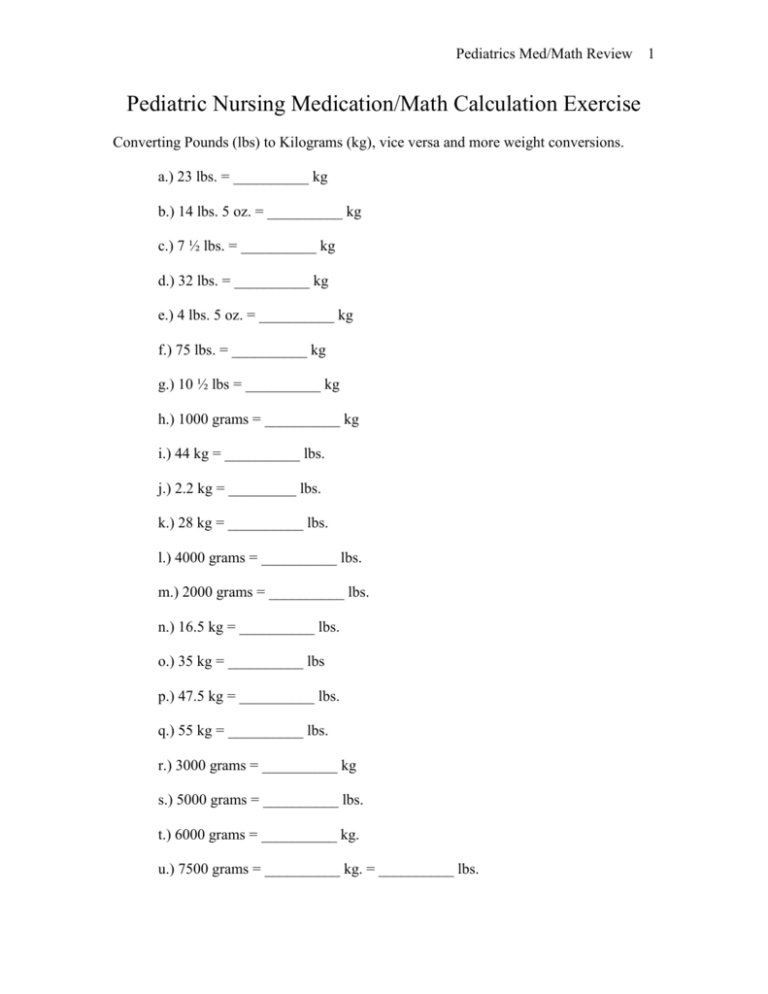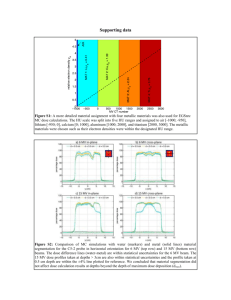Pediatric Nursing Medication/Math Calculation Exercise
advertisement

Pediatrics Med/Math Review Pediatric Nursing Medication/Math Calculation Exercise Converting Pounds (lbs) to Kilograms (kg), vice versa and more weight conversions. a.) 23 lbs. = __________ kg b.) 14 lbs. 5 oz. = __________ kg c.) 7 ½ lbs. = __________ kg d.) 32 lbs. = __________ kg e.) 4 lbs. 5 oz. = __________ kg f.) 75 lbs. = __________ kg g.) 10 ½ lbs = __________ kg h.) 1000 grams = __________ kg i.) 44 kg = __________ lbs. j.) 2.2 kg = _________ lbs. k.) 28 kg = __________ lbs. l.) 4000 grams = __________ lbs. m.) 2000 grams = __________ lbs. n.) 16.5 kg = __________ lbs. o.) 35 kg = __________ lbs p.) 47.5 kg = __________ lbs. q.) 55 kg = __________ lbs. r.) 3000 grams = __________ kg s.) 5000 grams = __________ lbs. t.) 6000 grams = __________ kg. u.) 7500 grams = __________ kg. = __________ lbs. 1 Pediatrics Med/Math Review 2 Case 1. You are administering triple antibiotics to an 8-year-old child who had surgery for a ruptured appendix. The client weighs 46.2 lbs. The usual dosing for the 3 antibiotics is: I.V. Ampicillin 200-400 mg/kg/day every 4-6 hours I.V. Ceftazidime 100-150 mg/kg/day every 8 hours I.V. Metronidazole 30 mg/kg/day every 6 hours 1.) Your client’s Ampicillin dose is ordered to be administered every four hours. The safe range for this client is __________ mg to __________ mg per DOSE. 2.) The safe dosing range of Ceftazidime for this client is __________ mg to __________ mg per DOSE. 3.) The safe dose for Metronidazole is __________ mg per DOSE. Case 2. The doctor wrote an order for 8.5 ml of Tylenol with Codeine Elixir PO every four hours PRN pain. The elixir comes as acetaminophen 120 mg/ Codeine 12 mg/ 5 ml. 4.) How many mg of Tylenol are you giving? __________ mg of Tylenol 5.) How many mg of Codeine are you giving? __________ mg of Codeine Case 3. Your client has 1000 mg of I.V. Ampicillin ordered and it is prepared in 10 ml. You plan to administer it over 10 minutes via a syringe pump. 6.) What will be your rate to set the syringe pump at? __________ ml/hr. Case 4. The doctor ordered 3 ml of Tylenol with Codeine Elixir PO every four hours PRN pain. The elixir comes as acetaminophen 120 mg/ Codeine 12 mg/ 5 ml. 7.) How many mg of codeine is in this dose? __________ mg Codeine Pediatrics Med/Math Review 3 Case 5. A 14 year-old adolescent boy who weighs 193.6 lbs. post-op day #1 receiving I.V. Zosyn (piperacillin sodium and tazobactam sodium) 3000 mg q 8 hours. Safe dose for Zosyn is 240-400 mg/kg/day. 8.) What is the safe dose range per day? __________ mg to __________ mg/day 9.) What is the safe range per dose? __________ mg to __________ mg/dose 10.) The maximum safe concentration is 200 mg/ml. How many ml’s would you need to dilute to have this concentration? __________ ml 11.) What will be your rate if we run this volume in 30 minutes in a syringe pump? __________ ml/hr. Case 6. Child weighs 20 lbs. MD order: Augmentin 150 mg PO q 8 hours. Information from drug guide states: children < 40 kg receive 6.7 to 13.3 mg/kg q 8 hours. The medication comes Augmentin 125 mg/ 5ml. 12. ) Convert 20 lbs to kg. __________ kg 13.) What is the safe dose range per dose? __________ mg to __________ mg/ dose 14.) Is the ordered dose in the safe range? __________ (Yes or No: and justify your answer). 15.) How many ml would you need to draw up to equal 150 mg? __________ml Case 7. Household measurements needed in health care. Recall ounces, tablespoons, etc. 16.) 10 tablespoons = __________ oz. = __________ ml. Pediatrics Med/Math Review 4 17.) 500 grams = __________ ml = __________ oz. Case 8. Child weighs 16 lbs 10 oz. Physician order: Lasix 15 mg PO BID. Information from the drug guide: The initial dose of Lasix (furosemide) for infants or children is 2 mg/kg/dose. If initial dose works, dosage may be increased to 1 to 2 mg/kg/dose as a maintenance dose. Doses greater than 6 mg/kg/day are not recommended. The medication comes: Furosemide 10 mg/ml. 18.) Convert 16 lbs 10 oz. to kg. __________ kg 19.) Calculate the initial and high dose: __________ mg initial dose and __________ mg high dose. 20.) Is the dose in the safe range? ________ (Yes or No: and justify your answer) 21.) How many ml would you need to draw up to equal 15 mg? __________ ml Case 9. Child weighs 66 lbs. Physician order: Epinephrine 0.3 mg Sub-Q x1 dose for allergic reaction. Information from drug guide: 0.01 mg/kg every 20 minutes as needed: not to exceed 0.5 mg in a single dose. The medication comes Epinephrine 1 mg/ml. 22.) Convert 66 lbs to kg. __________ kg 23.) Calculate low and high dose: __________mg low dose and __________ mg high dose. 24.) Is the dose in the safe range? __________ (Yes or No: justify your answer) 25.) How many ml would you need to draw up to equal the minimum or low dose? _____ ml Pediatrics Med/Math Review 5 Fluid Calculations: for I.V. fluid maintenance use the formula below. 24 hour Maintenance Allow 100 ml/kg for the first 10 kg of body weight Allow 50 ml/kg for the second 10 kg of body weight Allow 20 ml/kg for the remaining body weight Example: Child weighs 32 kg 100 ml x 10 for the first 10 kg of body weight = 1000 50 ml x 10 for the second 10 kg of body weight = 500 20 ml x 12 for the remaining body weight = 240 1000 + 500 + 240 = 1740 ml/24 hours o o o o o 1740 ml is needed for 24 hours 72.5 ml/hr will be the hourly rate (1740 divide by 24) 1 ½ times the maintenance will be 2610 ml (1740 x 1.5) ¾ maintenance will be 1305 ml (1740 x 0.75) ½ maintenance will be 780 ml (1740 divide by 2) Case 10. A severely dehydrated child due to vomiting and diarrhea weighs in at 28 kg. 26.) Calculate the 24 hour fluid requirement: __________ ml 27.) The doctor ordered 1 ½ times the maintenance fluids: __________ ml 28.) What would be your hourly rate for the regular maintenance and the 1 ½ times maintenance fluids? __________ ml/hr regular rate; __________ ml/hr 1 ½ times. Case 11. A child with polycystic kidney disease admitted for possible infection. The child weighs 36 kg. 29.) Calculate the 24 hour fluid requirement: __________ ml 30.) The doctor ordered ¾ maintenance fluids for hydration: __________ ml/24 hours. Pediatrics Med/Math Review Answers to Pediatric Nursing Medication/Math Calculation Exercise Conversions: a.) 10.45 b.) 6.50 c.) 3.41 d.) 14.55 e.) 1.96 f.) 34.09 g.) 4.77 h.) 1 i.) 96.8 j.) 4.84 k.) 61.6 l.) 8.8 m.) 4.4 n.) 36.3 o.) 77 p.) 104.5 q.) 121 r.) 3 s.) 11 t.) 6 u.) 7.5 and 16.5 Cases 1 – 11: 1. 700 – 1400 2. 700 - 1,050 3. 157.5 4. 38.4 5. 3.84 6. 60 7. 7.2 8. 21,120 – 35,200 9. 7,040 – 11,733 10. 15 11. 30 12. 9 13. 60.3 – 119.7 14. No, because safe range dose is 60.3mg to 119.7 mg/dose 15. 6 16. 5 and 150 17. 500 and 16.67 18. 7.56 6 Pediatrics Med/Math Review 19. 15.12 20. Yes, safe dose range is 15.12 mg – 45.36mg (slightly under dose but o.k.) 21. 1.5 22. 30 23. 0.3 and 0.5 24. Yes, safe dose range is 0.3 – 0.5 mg/dose 25. 0.3 26. 1,660 27. 2,490 28. 69.16 and 103.75 29. 1,820 30. 1,365 7






